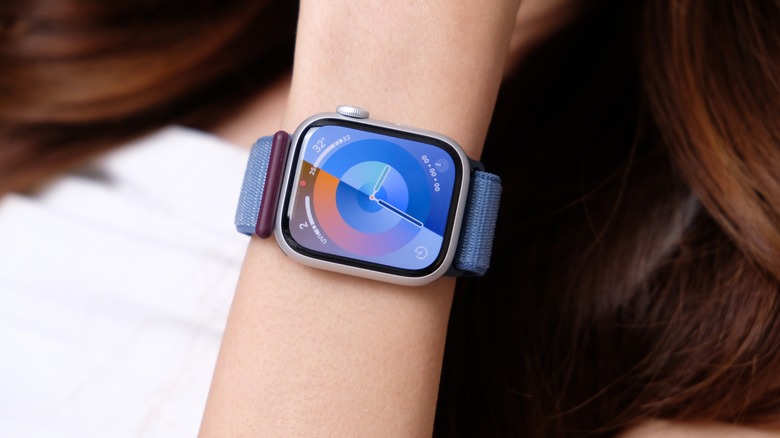
Framesira/Shutterstock
From choosing an aluminum vs. stainless case to deciding on a color, you have to make a lot of choices when buying an Apple Watch. That’s by design, as Apple has added features to personalize the ultimate product that ships to you, down to the size of the watch band. What you might not realize is that picking the size of the watch band is one of the most important decisions you’ll make when purchasing an Apple Watch. Beyond ensuring a comfortable fit, a correctly fitting watch band is vital to ensure the Apple Watch measures things like your heart rate more accurately during a workout.
The Apple Watch has several sensors that need to be in contact with your skin to work correctly, which is why getting the right fit is so important. If you’ve ever seen the green lights on the back of an Apple Watch, you got a glimpse of the sensor used to measure the wearer’s heart rate. If the watch’s strap is too loose, the sensors won’t be able to do their job.
The good news is that Apple tries to make getting the right fit for your watch easy. You can use Apple’s printable sizing tool to help you find the right fit before buying. Even then, sadly, there are more choices to make. The type of band you pick will determine your choice of sizes too, as some bands are measured from small to large while others use a system of numbers.
How to get the best fit for your Apple Watch
Once you’ve selected the size of the band for your Apple Watch, there are still a few things you should do. After placing the watch on your wrist, you can adjust the band’s tightness so it fits comfortably without being too tight or too loose. When using the Apple Watch to help get more out of your workout, you should consider tightening it while you’re exercising to give the sensors the best opportunity to record measurements accurately. You can always loosen it again after you’ve finished working out.
Keep in mind that the watch’s sensors need constant contact with your skin, even when you’re not exercising, for features like Wrist Detection to function properly. Placing your watch above your wrist bone in the direction of your elbow will help the sensors get the best contact with the skin.
It’s pretty easy to notice when your watch isn’t fitted properly. For example, if the watch isn’t reading your heart rate correctly or it moves around too much while you’re wearing it, that’s a sign you need to tighten the band. An easy test for how well your watch fits is shaking your arm to see how much it moves. If the back of your watch doesn’t maintain contact with your skin, you’ll likely need to adjust the band.
What if my Apple Watch irritates my skin?
Apple acknowledges that some people will experience skin irritation when wearing some of their bands made with certain materials. If you have sensitive skin, things like allergies, environmental factors, and even soap or sweat can cause a reaction. When this happens, your first instinct will probably be to loosen the band to get some relief. While this is an option, doing so may decrease the accuracy of the watch’s sensors.
Some Apple Watch models, including the stainless steel or aluminum Apple Watch Series 4 and later, and the Apple Watch SE, contain small amounts of nickel, which might cause a reaction for some people. The same goes for some Apple Watch bands.
Some Apple Watch accessories also have trace amounts of acrylates, a material that causes problems for some people. Sometimes, swapping out your current band for one made with a different material helps.
Apple acknowledges that wearing your band too tightly or loosely can also irritate your skin. Take your watch off and consider talking to your doctor if you experience redness, swelling, itchiness, or any other types of irritation.